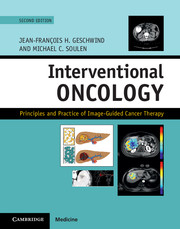Book contents
- Frontmatter
- Contents
- List of contributors
- Section I Principles of oncology
- Section II Principles of image-guided therapies
- 2 Principles of radiofrequency and microwave tumor ablation
- 3 Principles of irreversible electroporation
- 4 Principles of high-intensity focused ultrasound
- 5 Principles of tumor embolotherapy and chemoembolization
- 6 Principles of radioembolization
- 7 Principles of intra-arterial infusional chemotherapy in the treatment of liver metastases from colorectal cancer
- 8 Imaging in interventional oncology: Role of image guidance
- 9 Novel developments in MR assessment of treatment response after locoregional therapy
- Section III Organ-specific cancers – primary liver cancers
- Section IV Organ-specific cancers – liver metastases
- Section V Organ-specific cancers – extrahepatic biliary cancer
- Section VI Organ-specific cancers – renal cell carcinoma
- Section VII Organ-specific cancers – chest
- Section VIII Organ-specific cancers – musculoskeletal
- Section IX Organ-specific cancers – prostate
- Section X Specialized interventional techniques in cancer care
- Index
- References
4 - Principles of high-intensity focused ultrasound
from Section II - Principles of image-guided therapies
Published online by Cambridge University Press: 05 September 2016
- Frontmatter
- Contents
- List of contributors
- Section I Principles of oncology
- Section II Principles of image-guided therapies
- 2 Principles of radiofrequency and microwave tumor ablation
- 3 Principles of irreversible electroporation
- 4 Principles of high-intensity focused ultrasound
- 5 Principles of tumor embolotherapy and chemoembolization
- 6 Principles of radioembolization
- 7 Principles of intra-arterial infusional chemotherapy in the treatment of liver metastases from colorectal cancer
- 8 Imaging in interventional oncology: Role of image guidance
- 9 Novel developments in MR assessment of treatment response after locoregional therapy
- Section III Organ-specific cancers – primary liver cancers
- Section IV Organ-specific cancers – liver metastases
- Section V Organ-specific cancers – extrahepatic biliary cancer
- Section VI Organ-specific cancers – renal cell carcinoma
- Section VII Organ-specific cancers – chest
- Section VIII Organ-specific cancers – musculoskeletal
- Section IX Organ-specific cancers – prostate
- Section X Specialized interventional techniques in cancer care
- Index
- References
Summary
Introduction
High-intensity focused ultrasound (HIFU), also known as focused ultrasound (US), is a non-invasive image-guided therapy which has been primarily employed in the clinical realm for non-invasive thermal ablation of benign and malignant neoplasms. Real-time imaging guidance, treatment monitoring, and therapy control are achieved with either US or magnetic resonance imaging (MRI) guidance. HIFU clinical experience has been described in the treatment of leiomyomata (uterine fibroids), prostate (benign prostatic hypertrophy and cancer), breast, hepatic, renal, pancreatic, brain, and bone tumors, although for most of these tumors, relatively small numbers of treated patients have been described and widespread adoption of HIFU thermoablation remains limited. Ongoing technical challenges include the feasibility of treating large tumors within a finite treatment time, treating tumors prone to motion, and accessing targets when the acoustic window is restricted by intervening anatomy (e.g., ribs, bowel).
A range of provocative bioeffects of therapeutic US beyond thermoablation have the potential to be leveraged in the care of selected oncology patients. Hyperthermic effects can potentiate the release of thermosensitive drugs, enhance the permeability and retention (“EPR effect”) of chemotherapeutic agents or nanoparticles, sensitize tissues to radiation effects, and potentially augment therapeutic gene transfection within tumors. Mechanical effects of HIFU, including stable and inertial cavitation and radiation forces, also play roles in heat-sensitive drug and gene delivery, and the enhanced permeability of therapeutic molecules, and disruption of the blood–brain barrier (BBB). These are areas of ongoing and promising oncologic research.
This chapter will provide an overview of the principles and existing therapeutic platforms for HIFU, including US and MRI guidance, treatment planning, and monitoring capabilities. A summary of current and potential future clinical applications is also presented.
HIFU principles and bioeffects
History
HIFU is not a new technology. Its first medically applicable use was described by Lynn et al. in 1942; these authors designed a focused US system and executed preclinical testing in the brain. Subsequently, in the 1950s, the Fry brothers developed a clinical HIFU device intended to treat patients with neurological disorders like Parkinson's disease. This system employed radiography to determine target location in relation to the overlying calvarium and focused the US beam through a craniotomy.
- Type
- Chapter
- Information
- Interventional OncologyPrinciples and Practice of Image-Guided Cancer Therapy, pp. 20 - 34Publisher: Cambridge University PressPrint publication year: 2016



